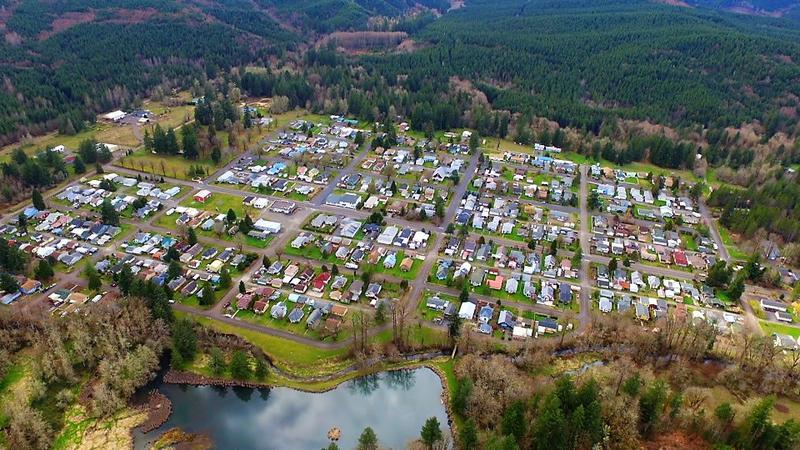
The Lifesaving Importance of Medical Alert Devices for the Elderly
As people age, the risks to their health and safety can increase significantly. From chronic illnesses and medication management t...

Seniorcenters.com is a free resource helping seniors and senior centers across America. Learn about our editorial processes.
Deep in the verdant foothills of western Washington, where mist clings to towering evergreens and quiet roads meander through ancient forests, lies a remarkable place with a story as unique as the landscape that cradles it. Ryderwood, Washington – a tiny hamlet that proudly bills itself as “the town with two histories” – stands as America’s oldest continuously running retirement community, a distinction it has held since 1953.

Once known as “The World’s Largest Logging Town,” Ryderwood began in 1923 as a logging settlement established by the Long-Bell Lumber Company at a cost of $1.5 million – the largest community built entirely with private funding at that time.
It was named after W.F. “Uncle Bill” Ryder, Long-Bell’s logging operations manager who had ventured to the Pacific Northwest to secure timber sources.
Unlike typical logging camps of the era, which often consisted of makeshift “skid shacks” housing bachelor workers, Ryderwood was revolutionary. Billed as “a place for families to live rather than bachelor workers,” it was considered a “modern logging town,” as an article in The Log of Long-Bell proudly proclaimed.
The company constructed proper homes, built a school, church, and even a theater – creating a true community where loggers’ families could establish roots and enjoy stability.
At its logging peak, Ryderwood’s population swelled to 2,000 residents with over 400 single-family homes. The town was substantial enough to support its own hospital.
But by the early 1950s, the landscape of the logging industry had dramatically changed. “In 1953, pretty much the loggers and the logs were gone and they were in the process of tearing the place down,” explains Cissy Sanders, one of the town’s historians.
It was at this pivotal moment that Ryderwood’s second chapter began – one that would ultimately secure its place in American history.
An “innovative real estate investor” saw potential where others saw obsolescence. Harry Kem Sr. and his company, Senior Estates, Inc., purchased the former logging town for $90,000 in 1953 and transformed it into what would become the country’s first planned retirement community.
The transition received media attention, with TIME magazine covering the event in its real estate section with an article titled “Old Folks at Home” in May 1953.
Senior Estates renovated the existing homes, with before-and-after photos showing the remarkable transformations of the former loggers’ residences into charming retirement cottages.
About half of the nearly 400 original homes were salvageable, with around 175 of these still occupied today. By 1955, an independent group of retirees had quickly taken advantage of the opportunity, purchasing all available homes.
The community continued to evolve over the decades. In the 1970s, Hacienda Estates built new homes, Cowlitz County Public Works replaced the aging water and sewer system in 1976, and Forum Investments took over ownership from Senior Estates in 1978, developing the remaining properties.
The retirees didn’t just move in – they became stewards of the town’s legacy while creating something entirely new. In 1955, the residents built a 6-acre lake, dedicated by then-Governor Langley, transforming a former gravel pit into a recreational centerpiece for the community.
They also reorganized the church, remodeled the community hall, and established the Ryderwood Improvement and Service Association (RISA) to manage the town’s operations – an organization that continues to govern Ryderwood to this day.
Today, nearly seven decades after its transformation, Ryderwood continues to thrive as a retirement haven. All 275 properties are privately owned with deeds that limit occupancy to those over the age of 55, in accordance with RISA bylaws and Cowlitz County covenants.
With monthly association dues of just $40 (as of my research), residents receive weekly trash collection, street lights, and maintenance of community properties.
The pace of life in Ryderwood is deliberately unhurried. The town is designated as a golf cart zone, though many residents prefer walking or cycling. The park, lake, paved streets, and surrounding woodland trails offer ample opportunities to enjoy the fresh air and natural beauty.
Community remains at the heart of Ryderwood’s identity. The Ryderwood Café serves as both dining establishment and social hub, offering meals several times weekly while functioning as a gathering place and the town’s designated emergency shelter, complete with backup generator.
Various clubs and organizations keep residents engaged, from the Women’s Club and VFW Post #7010 to the whimsically named “Ryderwood Crazy-Hats ladies” who “love to dress up in red and purple and have a good time.”
Ryderwood embraces both chapters of its history with equal pride. With Ryderwood approaching its centennial in 2023, members of the town’s AMVETS Post 7010 formed the Ryderwood History Project in 2015 (later transitioning to the Ryderwood History Club in 2021) to preserve and celebrate the town’s unique heritage.
The connection between past and present is maintained through annual gatherings. Survivors of the Long-Bell era and their families have held reunions nearly every year since 1954, with some traveling from as far away as North Carolina to attend.
Though their numbers diminish with each passing year, the tradition continues, with descendants carrying forward the memories of Ryderwood’s logging days.
As Ryderwood approaches its second century, it stands as a living testament to the power of community vision and reinvention. What began as an innovative company town for logging families transformed into an equally innovative retirement concept, creating a model that countless other communities would later emulate.
The town’s history mirrors America’s own evolution from a resource-extraction economy to a society increasingly focused on quality of life for its aging population. Yet unlike many planned communities that followed, Ryderwood retains an authentic character born of its unique origins and the genuine connections fostered among its residents.
For visitors who venture down State Route 506 to this tucked-away corner of Washington, Ryderwood offers a glimpse into both America’s logging past and a pioneering approach to retirement living that continues to flourish today. As resident Gene DeBriae simply puts it: “It’s a peaceful, quiet village in the woods, and people love it.”
In an age of disposable places and transient communities, Ryderwood stands as a reminder that with vision, adaptability, and a commitment to caring for one another, even the most specialized places can find new purpose and continue to thrive for generations to come.
No results available
Browse thousands of Senior Centers from around America. Senior Centers are an integral part of society and are the center of life for many seniors and aging adults.
Find a Senior Center which fits your needs using our search feature and keep up to date on all the latest news.
Click the icon to Ask Anything!
Advertisers are not endorsed by SeniorCenters.com or any senior center listed.
This site is not endorsed by or affiliated with any senior center or organization listed.
Just one helpful email per month – no clutter, just value.